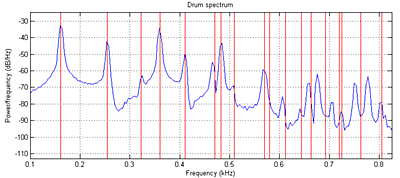sqrt(m+n) where m,n=1,2,3,...Where the first term (
sqrt(2)) corresponds to the fundamental mode of the drum.The first few modes are
sqrt(2), sqrt(5), 2*sqrt(2), sqrt(10), sqrt(13), sqrt(17), sqrt3*sqrt(2).
For this exercise, you will simulate the 2D wave equation on a square mesh in realtime to produce drum-like sounds.
This year we will add a nonlinear effect related to the instantaneous tension in the mesh.
Procedure:
Read Study Notes on Numerical Solutions of the Wave Equation with the Finite Difference Method. The main result you will need to simulate is equation 2.18. A matlab program gives a sequential version of the algorithm and plots the Fourier modes of the drum. Another version is tuned to middle C (261 Hz). You can see in the figure below that the simulated sound spectrum (blue) matches the theoretical drum modes (red) up to about mode 8 or 9 (see Physical modeling with a 2D waveguide mesh for details) . The theoretical square drum mode frequencies follow the ratio sequence:
sqrt(m+n) where m,n=1,2,3,...
Where the first term (sqrt(2)) corresponds to the fundamental mode of the drum.
The first few modes are sqrt(2), sqrt(5), 2*sqrt(2), sqrt(10), sqrt(13), sqrt(17), sqrt3*sqrt(2).

Modifying the boundary conditions, damping, wave speed, drum size, and distrubution of input energy can modifiy the sound of the simulation from drum-like, to chime-like, to gong-like or bell-like. You can modify the program further to include frequency-dependent damping and other effects. This version simluates a long, thin bar struck at one end.
Adding tension modulation allows pitch bending observed in a real drum after a large amplitude input. The large amplitude means that the membrane is stretched more, and therefore the speed of propagation (and therefore pitch) is increased. This matlab code produces an exagerated pitch effect with initial high amplitude. See also PHYSICALLY-BASED SYNTHESIS OF NONLINEAR CIRCULAR MEMBRANES equation 10.
You will probably want to read
for ideas on parallelization.
Also read documentation on incremental compilation. Some compile times may be very long.
To avoid long compile read Using ModelSim to test node computations
You may want to read the Evans and Sutherland HDL guide, chapter 9, for info on using generate statement.
The hardware audio interface is a Wolfson
WM8731 codec which is controlled by an I2C interface.
This hardware is hidden behind Altera IP called the University Audio Core for Qsys.
An example using the audio core is near the bottom of the Avalon Bus master page.
Cyclone5 handbook describing available hardware, but here is a summary.
Using Cyclone5 memory blocks.
Cyclone5 DSP blocks description and arithmetic megafunctions
HDL style -- inferring memory and DSP blocks, and a post from Mohammad
Verilog HDL Synthesis Attributes and Directives
-- RAM-style synthesis parameter
-- MULT-style synthesis parameter
Testing:
Student examples running on FPGA:
10*(number of wave equation nodes)*(audio sample frequency) . 123x106
operations/sec. Clearly some parallel processing will be necessary as you go to higher numbers of nodes.
Be prepared to demo your design to your TA in lab.
Your written lab report should include the sections mentioned in the policy page, and :